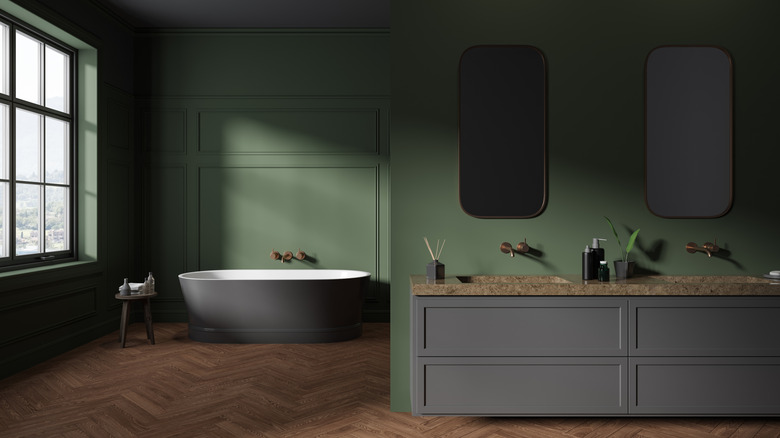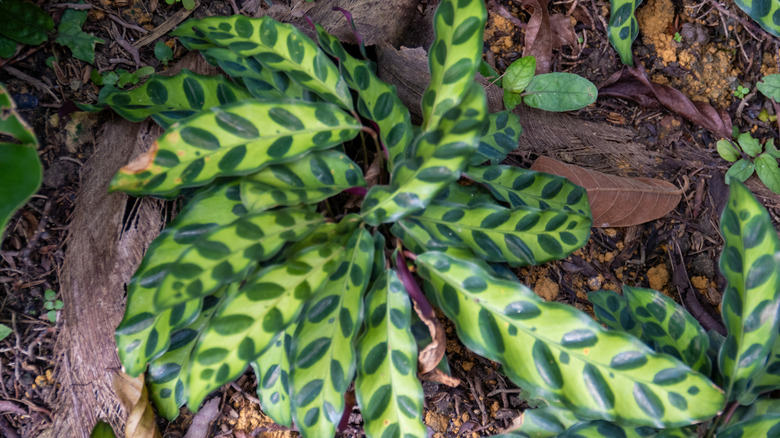The Indoor Plant That Thrives In Dark, Humid Areas
Keeping indoor plants has wonderful health benefits. Houseplants are known to reduce stress and blood pressure, as well as improve your mental state. With that in mind, you may aim to work out your green thumb by growing plants in as many rooms as possible, only to find that the living room, with tons of light coming from your bay window, is a much more viable environment than darker, more humid spaces like the bathroom. Luckily, there are indoor plants that can thrive where there's hardly any light; you just have to know which flora is good to grow where. For dark, humid areas, tropical plants known for thriving in the rainforest are going to be your best friend; for example, you can consider a rattlesnake plant (Geoppertia insignis), otherwise known as rattlesnake calathea.
Rattlesnake plants are ideal houseplants not just for the fact that they thrive in deep shade, but also because this Brazilian evergreen perennial has a high rate of oxygen production to help purify the air. Indoor pots are essentially the only option for anyone interested in growing a rattlesnake plant across the United States, given that it only grows in USDA Hardiness Zones 11 and 12, which puts it squarely within the range of garden planting for Hawaii and Puerto Rico. Luckily, keeping these beautiful, distinctly patterned plants at home means you can control their care conditions, as these fast-growing perennials are pretty high maintenance.
Rattlesnake plants require a careful balance of water to grow big and strong
An excess of moisture in your bathroom can lead to the development of mold, a huge problem if left unchecked. However, Geoppertia insignis is one of many moisture-loving plants that are perfect for your bathroom. It wants to be kept in a balmy environment, around steady 65 to 75 degrees Fahrenheit, with well-drained soil that has high organic matter, and a slightly acidic pH. Peat moss makes a great mix-in for any growing media you use, as it's an organic component that helps retain extra moisture for your tropical plants.
You'll want to water your rattlesnake plant only when the top of the soil feels dry, but it may help meet the plant's high humidity requirements if you let it rest on a bed of wet pebbles and regularly mist the leaves. The amount of time you spend watering should be reduced come winter, despite the fact that it's going to be less exposed to the elements as a houseplant. You should similarly drop your fertilizer schedule from monthly applications to every other month. Another important thing to keep in mind if you want to grow your own rattlesnake calathea is that the plant requires a decent amount of space. It should have upwards of 3 feet to itself, and can grow over a foot-and-a-half tall indoors.
Rattlesnake plants make great decor if you can avoid diseases
Plants that require a lot of water, especially those from tropical regions, are going to be more susceptible to a handful of different diseases. For example, you want to avoid overwatering to the extent of giving your rattlesnake plants root rot, and getting the leaves wet may result in fungal spots. However, on the opposite end of this carefully balanced spectrum, keeping these plants in a space that lacks sufficient humidity might result in wilted, withering leaves. Despite the fact that you'll have to be more cautious, rattlesnake plants are perfect to grow indoors for other reasons, notably that they aren't toxic to house pets like cats and dogs.
Rattlesnake plants' namesake patterning and unique color scheme make the species a great accent piece, especially during the fall season. The plant has dark green leaves with purple coloration underneath, and is known to unfold its leaves come morning so it can capture more of its limited sunlight. It's a popular Halloween-themed plant as a result, putting it in good company with DIY decor succulents like 'living stone' Lithops. If you've got the time and energy to devote toward plants that require a bit more work, a rattlesnake plant may be perfect for those dark, humid corners of your home that currently sit empty.


